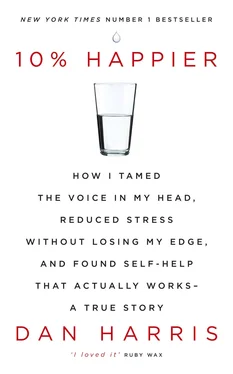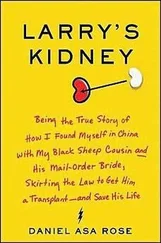The instructions were reassuringly simple:
1. Sit comfortably. You don’t have to be cross-legged. Plop yourself in a chair, on a cushion, on the floor—wherever. Just make sure your spine is reasonably straight.
2. Feel the sensations of your breath as it goes in and out. Pick a spot: nostrils, chest, or gut. Focus your attention there and really try to feel the breath. If it helps to direct your attention, you can use a soft mental note, like “in” and “out.”
3. This one, according to all of the books I’d read, was the biggie. Whenever your attention wanders, just forgive yourself and gently come back to the breath. You don’t need to clear the mind of all thinking; that’s pretty much impossible. (True, when you are focused on the feeling of the breath, the chatter will momentarily cease, but this won’t last too long.) The whole game is to catch your mind wandering and then come back to the breath, over and over again.
I sat on the floor with my back up against the bed and my legs sprawled straight out in front of me. I set the alarm on my BlackBerry to go off in five minutes and let rip.
In.
Out.
In.
Shrubbery . I like that word.
Why, from an evolutionary perspective, do we like the smell of our own filth?
Get in the game, dude.
In.
Out.
My butt hurts. Let me just shift a little bit here.
In.
Idea for old-school hip-hop show: Rap Van Winkle .
Now I have an itch on the ball of my left foot.
Where do gerbils run wild? Would I describe myself as more of a baller or a shot caller? What was the best thing before sliced bread?
And so it went until the alarm went off. By which point it felt like an eternity had passed.
When I opened my eyes, I had an entirely different attitude about meditation. I didn’t like it, per se, but I now respected it. This was not just some hippie time-passing technique, like Ultimate Frisbee or making God’s Eyes. It was a rigorous brain exercise: rep after rep of trying to tame the runaway train of the mind. The repeated attempt to bring the compulsive thought machine to heel was like holding a live fish in your hands. Wrestling your mind to the ground, repeatedly hauling your attention back to the breath in the face of the inner onslaught required genuine grit. This was a badass endeavor.
I resolved to do it every day. I started getting up a little early each morning and banging out ten minutes, sitting on the floor of our living room with my back up against the couch. When I was on the road, I meditated on the floor of hotel rooms.
It didn’t get any easier. Almost immediately upon sitting down, I’d be beset by itches. Then there was the fatigue: a thick ooze, a sludge-like torpor sliding down my forehead. Even when the itches and fatigue lifted, I was left contending with the unstoppable fire hose of thoughts. Focusing on the breath as a way to temporarily stop the thinking was like using a broom to sweep a floor crawling with cockroaches. You could clear the space briefly, but then the bugs came marauding back in. I knew I was supposed to just forgive myself, but I found that to be extremely difficult. Every time I got lost in thought, I went into a mini shame spiral. My wanderings were so tawdry and banal. Is this really what I was thinking about all the time? Lunch? Whether I needed a haircut? My unresolved anger at the Academy for awarding Best Picture to Dances with Wolves instead of Goodfellas ?
When I wasn’t lost in random musings, I was obsessing about how much time was left, dying for the ordeal to be over. It was like that Simpsons episode where they showed the world-record holder for longest consecutive case of the hiccups. In between hiccups, she would say, “Kill me.” By the end of ten minutes my jaw was often gritted from the effort. It reminded me of how one of our cats, Steve, who had a serious gum disease, would sometimes literally try to run away from himself when he was in pain. Similarly, when the alarm would go off at the end of a meditation session, I often would bolt out of my seated position, as if I could somehow physically escape the commotion of my own mind.
There were always happy, round-faced statues of the Buddha out front at airport spas and Chinese restaurants. (Although, I had come to learn that the “laughing Buddha” is actually a medieval Chinese monk who somehow became conflated in the Western imagination with the historical Buddha, who only ate one meal a day and was most likely a bag of skin and bones.) His image was bedazzled onto T-shirts sold in the gift shop at my gym. The word Zen had become synonymous with “mellow.” But this was all false advertising. Buddhist meditation was diabolically hard. Despite its difficulties, though, meditation did offer something huge: an actual method for shutting down the monkey mind, if only for a moment. It was like tricking the furry little gibbon, distracting it with something shiny so it would sit still. Unlike Tolle, who offered very little by way of actionable advice, meditation presented a real remedy, a temporary escape route from the clammy embrace of self-obsession. It may have been miserable, but it was the best—and only—solution I’d heard yet.
Pretty quickly, my efforts began to bear fruit “off the cushion,” to use a Buddhist term of art. I started to be able to use the breath to jolt myself back to the present moment—in airport security lines, waiting for elevators, you name it. I found it to be a surprisingly satisfying exercise. Life became a little bit like walking into a familiar room where all the furniture had been rearranged. And I was much better at forgiving myself out in the real world than while actually meditating. Every moment was an opportunity for a do-over. A million mulligans.
Meditation was radically altering my relationship to boredom, something I’d spent my whole life scrambling to avoid. The only advice I ever got from my college adviser, a novelist of minor renown named James Boylan (who later had a sex change operation, changed his name to Jenny, wrote a bestselling book, and appeared on Oprah ) was to never go anywhere without something to read. I diligently heeded that guidance, taking elaborate precautions to make sure every spare moment was filled with distraction. I scanned my BlackBerry at stoplights, brought reams of work research to read in the doctor’s waiting room, and watched videos on my iPhone while riding in taxicabs.
Now I started to see life’s in-between moments—sitting at a red light, waiting for my crew to get set up for an interview—as a chance to focus on my breath, or just take in my surroundings. As soon as I began playing this game, I really noticed how much sleepwalking I did, how powerfully my mind propelled me forward or backward. Mostly, I saw the world through a scrim of skittering thoughts, which created a kind of buffer between me and reality. As one Buddhist author put it, the “craving to be otherwise, to be elsewhere” permeated my whole life.
The net effect of meditation, plus trying to stay present during my daily life, was striking. It was like anchoring myself to an underground aquifer of calm. It became a way to steel myself as I moved through the world. On Sunday nights, in the seconds right before the start of World News , I would take a few deep breaths and look around the room—out at the milling stage crew, up at the ceiling rigged with lights—grounding myself in reality before launching into the unreality of bellowing into a camera with unseen millions behind it.
All of this was great, of course, but as it turns out, it wasn’t actually the main point.
Читать дальше












